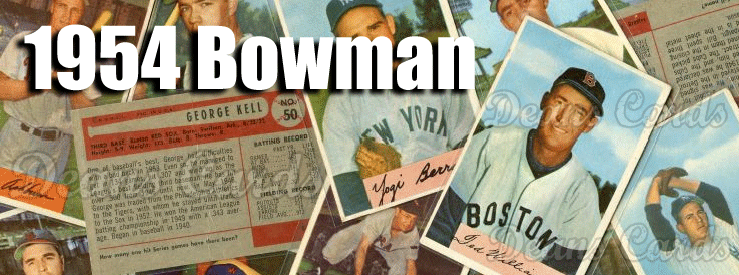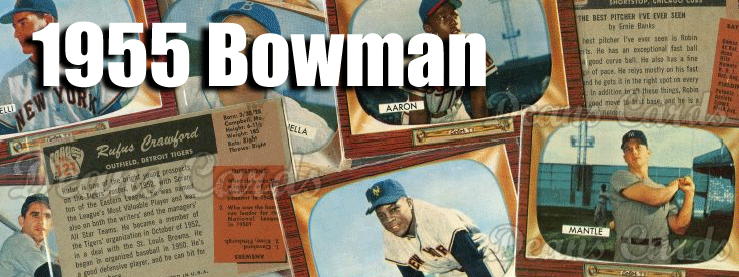by
+Dean Hanley
Black and White TV’s were starting to populate American homes, and television was quickly becoming another way for Americans to enjoy their national pastime. The first color television set appeared in the stores in 1954 and Bowman felt that it would be a fun and classy way to highlight their
1955 baseball card set.
Collectors of vintage cards know the
1955 Bowman baseball cards as the “T.V. Set”. The set itself consists of 320 cards, with the high number series (cards #225 - #320) as the most expensive.
The wood grain border being the distinctive mark of this set hides corner wear better than one would expect. Cards #1 to #64 feature a lighter blond-colored wood border and cards from #65 -#320 feature a darker-colored wood border. Inside the card’s border, the player's color photo is shown on the TV’s “screen”.
Set Features
The 1955 Bowman baseball cards were sold in one card penny packs or a six card pack that cost a nickel. Both, of course, included a stick of Blony bubble gum. The cards size remained at the standard 3 3/4" by 2 1/2" dimension Bowman had adopted in 1953. In comparison to Topps cards, Bowman’s cards are slightly thinner.
By 1955, Bowman had signed more players to exclusive contracts than Topps, yet Bowman still had to scrape the bottom of the barrel to find enough images for 320 cards. The set contains cards for players who had very short, unremarkable careers, such as managers, coaches and even umpires. Many of the players would never have another card printed.
All of the player pictures were taken in Shibe Park in Philadelphia, the home of the Bowman Gum Company. Many of the player photos feature Shibe Park’s characteristic green wall in the background.
Card Backs
For one of the few times in a vintage card set, the backs of the
1955 Bowman cards are not standard. Many cards have the standard career highlights but some quote the featured player. "The Best Hitter I've Ever Seen," "My Favorite Baseball Story," "My Childhood Hero," "My Biggest Thrill in Baseball" and "My Advice to Youngsters".
Although I am all for creative and innovative ideas, not having the statistics on every player’s card is a bad one, witnessed by the fact that the idea was never repeated. Part of the fun of collecting cards is to flip it over and look at a player’s statistics.
Another problem is that most of the stories are fairly routine and somewhat boring, even to a baseball historian, like myself. The player’s advice usually is along the lines of "practice hard and be good", which are still popular clichés used by today’s players. I guess it is unreasonable to expect advice on how to sneak out past curfew, which player they considered the biggest jerk or most over-rated, or what they really thought of their manager. Now that would have made for a great set of cards!
The stories often refer to a memorable event like the player’s first game or home run. One of the funniest stories is told by Virgil Trucks:
"It was my first year in the big leagues. I was pitching against the Boston Red Sox. The first hitter was
Bobby Doerr. He doubled on the first pitch. The next hitter did the same, and the next one tripled, again on the first pitch.
Ted Williams came to the plate. He hit the first pitch too, for a home run. Manager
Del Baker came to the mound and asked
Bob Swift, my catcher, 'Doesn't Virgil have it today?' Swift answered, 'How do I know? I haven't caught one yet!'"
The most unique story has to be that of
Eddie Waitkus (#4), whose "greatest thrill" begins: "In 1949, I was shot by a deranged girl." I imagine that Waitkus's story, which was the basis for the movie "The Natural," confounded more than a few of the boy collectors of the day.
In my opinion, the most interesting information contained on the
1955 Bowman card backs is finding who the players considered the toughest hitter or pitcher in the game. While there was no clear consensus as to who was considered the toughest pitcher to face in either league,
Warren Spahn and
Bob Feller were mentioned the most often.
The pitchers of the day were much more unified on whom they did not wish to see standing in the batter’s box holding a piece of lumber. Almost every pitcher named either
Stan Musial or
Ted Williams as the best hitter in his respective league. It is not a credit to the
1955 Bowman set that neither player has a card in the set for this year.
Rookie Cards
One of the major negatives voiced about the Bowman sets issued during the Bubble Gum Card War is the lack of outstanding rookie cards, as compared to Topps. On the surface, the
1955 Bowman set seems to also be afflicted, especially with the 1955 Topps set featuring future Hall-of-Famers such as:
Roberto Clemente, Harmon Killebrew and
Sandy Koufax. While it is true that all of these players had outstanding careers, they took a while to become great and none played in the All-Star Game until 1959.
The two biggest rookie cards in the set are #68
Elston Howard and #296
Elroy Bill Virdon, both of whom had good years in 1955.
The Men in Black
The umpire cards are the most difficult cards in the set to find. Not only were they issued in fewer numbers, as part of the high-number series, the umpires were understandably ignored by the kids who purchased baseball cards. Part of what makes the umpire cards so difficult to find is that they were often thrown away by kids looking for their baseball heroes. The umpire cards feature short biographies and included facts such as the national heritage of the umpires as well as personal hobbies, family and professional sports, or umpiring experience.
Curiously, the Bowman Company put the umpires in the last series, which historically competed with the football card sets that were being released at the same time. Kids who had already bought the previous two series full of players and had no interest in the coach and umpire-heavy last series. Topps was busy releasing the
1955 Topps All-American football card set and Bowman was releasing their
1955 football card set, so most kids spent their nickels on those sets instead.
The 1955 Bowman umpire cards represent a fun challenge to collectors and another example of baseball cards that went from unpopular to considerably valuable. Although baseball cards have had many innovations over the years, issuing umpires in the set has never been attempted again.
Aftermath
As much as I like the unique design of the
1955 Bowman baseball card set, it still falls a bit short when compared to the Topps issue for that same year. Although color televisions were a very big deal at the time, the concept did not translate that well to baseball cards.
The biggest flaw, with the front of the
1955 Bowman cards, is the same one that Bowman had the previous year. There is too much wasted canvas space. Most of the pictures of the players are standing upright, resulting in small pictures and a lot of empty background. The design of the
1955 Topps set did a much better job of filling the canvas and creating a more attractive product.
Despite Bowman’s advantage in exclusive player contracts and Bowman’s many innovations on the design of the cards, Topps again produced a more attractive baseball card. For the fourth straight year, the kids choose the Topps product over the cards issued by Bowman and that is where they spent their money.

Although few realized it in 1955, the TV set would be the last baseball card set for the floundering Bowman Gum Company.
The 1955 Bowman Baseball card set has since become a hobby classic with its unique design and charming quirks.
This article is taken from Dean’s book “The Gum Card War and the Great Bowman & Topps Baseball Card Sets of 1948-1955”, which is now available for sale at Amazon.com.
Dean Hanley is an authority on vintage sports cards and has written numerous articles on the topic. Mr. Hanley is the founder DeansCards.com, and with well-over one million vintage cards in inventory, DeansCards.com is the largest seller of vintage cards on the web. Dean has also published “Before there was Bubble Gum: Our Favorite Pre-World War I Baseball Cards”, which is also available in eBook form at Amazon.com and has just released a T207 reprint set. For more information, please visit www.DeansCards.com
If you are looking to sell your cards we would be happy to hear from you. Please fill out our sell your collection form here and we will be in touch.

 To Review "Before There Was Bubble Gum: Our Favorite Pre-World War I Baseball Cards” click here.
To Review "Before There Was Bubble Gum: Our Favorite Pre-World War I Baseball Cards” click here.  To review "The Bubble Gum Card War: The Great Bowman & Topps Sets from 1948 to 1955” click here.
To review "The Bubble Gum Card War: The Great Bowman & Topps Sets from 1948 to 1955” click here. 















































